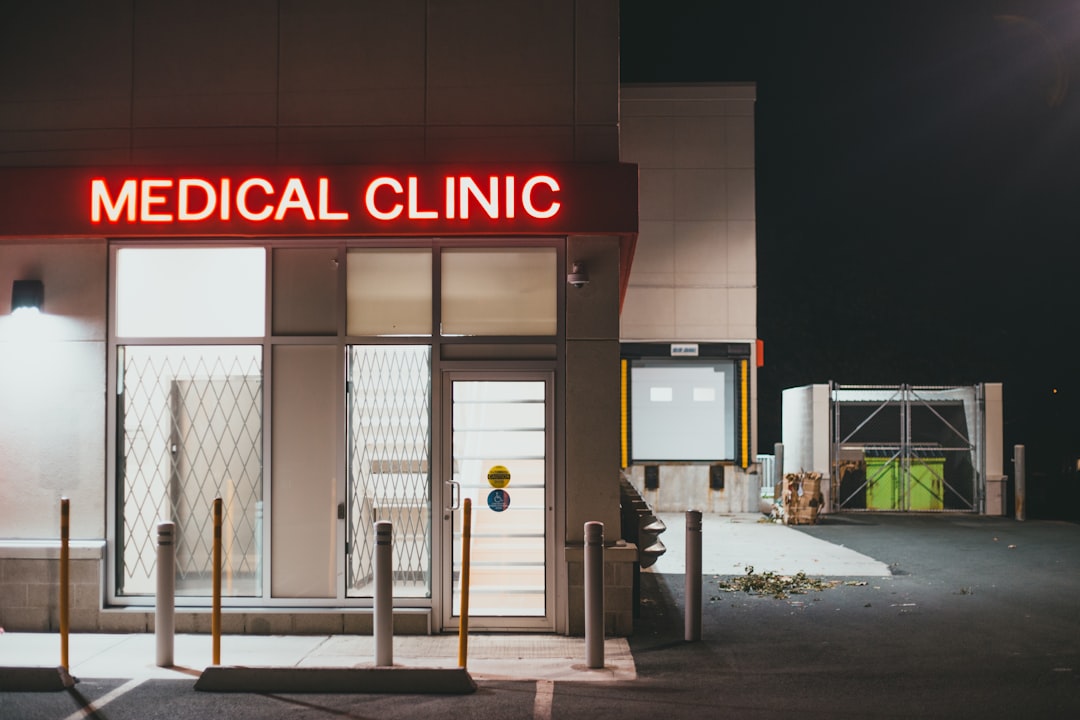

Engage prospects with a scan and streamline customer engagement with FREE QR code marketing tools by Sona – no strings attached!
Create a Free QR CodeFree consultation

No commitment

Engage prospects with a scan and streamline customer engagement with FREE QR code marketing tools by Sona – no strings attached!
Create a Free QR CodeFree consultation

No commitment
Medical malpractice law firms operate in a high-stakes, competitive landscape where trust, credibility, and clear communication drive client acquisition and retention. However, countless high-value prospects remain invisible because they never submit a form, making the process of capturing new business challenging. As individuals search for local medical malpractice attorneys or consider engaging legal counsel for potential negligence cases, their journey is dotted with physical and digital touchpoints. Many of these are missed opportunities if not tracked effectively. When these moments of intent are not captured in the CRM, promising cases can slip away without ever engaging a firm’s expertise.
QR codes in marketing have emerged as a catalyst for bridging the gap between the real world and digital channels. For medical malpractice law firms, these codes allow firms to collect client feedback at the precise moment of experience, direct prospects to targeted legal resources, and streamline intake processes that previously relied on paper forms or prolonged follow-up calls. As technology transforms legal marketing strategies, being able to engage clients and gather actionable data in real time without forcing them to download apps or fill out lengthy paperwork has become a crucial differentiator in a landscape where delay often means losing a case to a competitor.
By leveraging QR codes to gather feedback and connect physical interactions with digital data, medical malpractice law firms can not only improve their service reputation but also unlock strategic insights overlooked by manual workflows, optimize campaigns with enriched knowledge of both prospects and clients, and fuel growth through smarter, data-driven audience engagement. With platforms like Sona QR and Sona.com, firms can capture intent at the moment it happens, connect the dots across channels, and tie real-world scans to consultations and revenue.

Obtaining timely, honest feedback is a perennial challenge, especially when clients are reluctant to engage with traditional surveys or manual intake forms. High-value leads too often go unidentified, and late feedback can leave important satisfaction signals undiscovered until after issues arise. QR codes reduce friction across legacy workflows like paper surveys, printed brochures, and manual client intake forms, then route responses directly into a centralized system that your intake and client service teams actually use. For quick survey setup, try this google forms QR guide.
Strategically deploying QR codes at key touchpoints ensures feedback reaches the right person at the right time. Place codes in consultation rooms, on sign-in cards, at event booths, and on post-case documentation. Prompt clients and prospects to scan with clear calls to action, then present a mobile-first form that takes less than two minutes to complete. You will see higher participation, more candid responses, and signals you can act on in real time.
Advanced QR solutions like Sona QR enable rapid deployment, real-time engagement tracking, and automated feedback routing. Embed QR codes on appointment reminders, video consultation backdrops, and post-resolution letters. When scanned, these codes can route clients to feedback or review prompts that only take seconds to complete. The scan event updates your CRM immediately and can trigger a workflow in tools like HubSpot CRM, ensuring timely outreach and service recovery when needed.
Replacing analog processes with QR-driven flows shortens the loop from experience to insight. Instead of waiting for end-of-month survey compilations or relying on anecdotal reports, you capture lived client sentiment while the details are fresh. The result is a continuous improvement engine that raises service quality, builds reputation resilience, and reveals growth opportunities hidden by slower, paper-based methods.

Medical malpractice law firms regularly face the challenge of converting offline interest, often sparked by referrals, events, or print materials, into actionable digital engagement. Prospects may browse printed materials or attend seminars without ever making themselves known, causing potential cases to remain nothing more than anonymous traffic. QR codes close that gap by turning passive discovery into measurable action with a single scan. For context on adoption, see this overview of law firm QR codes.
Speed and simplicity matter in this practice area because timelines influence case viability and client confidence. No one wants to download an app to leave feedback, access a resource library, or request a consultation. A QR code presents the fastest path to action. Layer dynamic content and tracking on top, and you have a flexible, measurable system that adapts as your campaigns and regulations evolve. Explore ideas for dynamic QR codes.
For a medical malpractice firm, the value is both operational and strategic. You reduce the paperwork burden and capture measurable signals during critical moments such as immediately after a consultation, at the close of a matter, or during community education events. Then you transform those signals into timely follow-ups that improve client outcomes, boost public reviews, and accelerate high-intent consultations.
Choosing the appropriate QR format matches the action you want a client or prospect to take. In medical malpractice, the most useful formats are those that lead to forms, resources, and direct contact with the firm. Dynamic codes offer the added advantage of editing destinations without reprinting, while static codes are best reserved for evergreen content.
Use static QR codes for permanent resources like an “About the firm” page or evergreen client education PDFs. Use dynamic QR codes for campaigns, intake flows, and anything that may change over time. With Sona QR, your team can manage both types in one place, swap destinations when needed, add UTM parameters for analytics, and view performance by code, channel, and placement.

Even the most reputable medical malpractice law firms lose business when prospective clients slip through the cracks. This often happens when print ads are not trackable, when seminar attendees leave without converting, or when post-consult follow-up relies on voicemails and paper forms. QR codes convert those risky moments into measurable engagements that lead to consultations and feedback you can act on. For a roundup of tactics, see this primer on QR marketing for law firms.
Think about placements that coincide with emotional or high-intent moments. A patient’s caregiver reading your brochure in a waiting room may be ready to learn whether there is a case. A former client completing a matter may be prepared to leave a review or share an anonymous satisfaction score. QR codes make those actions quick and private, improving participation and candor.
In all cases, add a clear benefit-driven CTA. For example, “Scan to check eligibility in 60 seconds” or “Scan to share feedback, 2 questions” sets expectations and emphasizes the value exchange. Make sure you comply with attorney advertising rules and privacy best practices by including a link to your privacy policy and a short disclaimer where appropriate.

Persistent pain points such as low feedback participation and reputational vulnerability persist because traditional feedback flows are cumbersome and easy to ignore. QR codes offer a faster, more engaging path to action, while providing data you can use to prioritize follow-up and improve the client experience.
These are the highest-impact use cases in medical malpractice settings, mapped to common interactions and outcomes:
Each use case can be powered by dynamic QR codes so destinations can be updated as campaigns evolve. With platforms like Sona QR, you can also A/B test landing pages and CTAs to determine which prompts drive the highest scan-to-completion rates.
Each QR scan is a strong behavioral signal. It indicates what content resonated, when and where the person engaged, and how far they progressed in your journey. By assigning unique QR codes to discrete touchpoints, your firm can automatically segment audiences and tailor follow-up based on context and intent.
Map scans to lifecycle stages so every interaction feeds a relevant nurture path. For example, someone who scanned a code on a brochure about birth injury claims should receive educational content about statutes of limitations and documentation checklists, not generic malpractice messaging. Someone who scanned a post-case satisfaction survey should be placed in an alumni outreach track with review and referral prompts.
For medical malpractice specifically, consider audience groupings such as prospective claimants, caregivers, referring clinic staff, active clients in the first consult phase, and post-resolution alumni. These distinctions support both sensitivity and effectiveness. Your messages should acknowledge context without making assumptions, and your cadence should respect the emotional intensity and confidentiality needs unique to malpractice matters.
QR codes are connectors across offline and digital campaigns. They capture real-time engagement from print and in-person moments, then pass that signal to your marketing automation and CRM systems. For medical malpractice firms, this means attribution clarity across assets that were previously hard to measure, plus the ability to meet prospects where they are with content that answers their most pressing questions. For additional ideas, explore QR marketing for law firms.
The key is to align QR codes with your channel strategy and to deploy a consistent design system so people instantly recognize what they will get from a scan. Use Sona QR to centralize management, roll out UTM tagging, and monitor performance by channel and placement.
QR codes serve as the offline onramp to your digital marketing engine. They also unlock a layer of data collection across channels that were once difficult to measure. With a centralized platform like Sona QR, you can manage all your codes, monitor performance, and sync scan data with your CRM and ad platforms to keep the flywheel spinning.
Successful QR campaigns are designed with a clear outcome in mind, supported by thoughtful placement, strong calls to action, and a measurement plan. In medical malpractice, this means balancing sensitivity with clarity, and making sure every scan leads to a safe, informative experience.
Before you begin, decide how you will handle data: what fields are necessary, how you will store and protect them, and what triggers should fire in your CRM. Then build your content so it answers the questions most prospects have in their first minutes of research. Keep forms short, use progressive profiling, and always include a direct path to schedule time with an attorney.
A platform that supports not just deployment but also real-time measurement and CRM integration enables law firms to learn and scale quickly. Sona QR centralizes code management while Sona.com extends attribution so you can connect scans to pipeline and revenue.

One of the toughest challenges for law firm marketers is tying offline and online actions to revenue. Attribution gaps make it difficult to prove which campaigns drive consultations or closed cases, leading to questions about spend justification. QR codes reduce uncertainty by producing a measurable signal at the exact moment someone engages with your print or in-person materials.
Treat each scan as the first step in a journey you can now observe. The scan leads to a micro-conversion such as form start, then to a consultation booking, then to a signed engagement. With the right tools, you can attribute these downstream outcomes to the original asset or campaign that drove the scan, then adjust your budget in near real time. For framework and tactics, read Sona’s blog post on offline attribution.
Sona QR captures real-world engagement. Sona.com turns that engagement into insights you can act on, helping you prove ROI, defend budget, and accelerate growth by shifting spend toward channels that move the needle.
Scaling QR impact requires consistent execution and a feedback loop. The following best practices help maximize scan rates, preserve privacy, and translate engagement into business outcomes that matter.
Begin by standardizing your design system. Use a consistent CTA library and visual frame so your codes are recognizable across materials. Implement a naming convention in Sona QR so you can filter performance by practice area, location, and placement. Then automate everything you can: alerts for high-intent scans, nurture sequences based on scan context, and review requests that trigger after matter resolution.
Respect the sensitive nature of malpractice matters in every deployment. Keep forms short, avoid collecting unnecessary personal health information in initial scans, and include a notice that scanning or form submission does not create an attorney-client relationship until confirmed by the firm. This protects both the client and the firm while maintaining a smooth experience.
QR campaigns in medical malpractice thrive when they align with high-intent moments and remove friction from the next best action. Below are representative examples of how firms have used QR codes to gather feedback, strengthen reputation, and grow consultations. The specific numbers will vary by firm and market, but the patterns hold across deployments.
QR codes have become more than a shortcut; they are a critical bridge connecting offline experiences with actionable digital journeys for medical malpractice law firms. As firms confront missed opportunities, anonymous website visits, and manual gaps that delay outreach, strategically placed QR codes on appointment cards, brochures, seminar materials, and office signage empower clients to provide instant feedback, explore valuable resources, or initiate legal consultations in real time.
The ability to surface and act on intent signals, gather actionable feedback at decisive moments, and accurately track marketing impact means that QR-driven engagement will remain indispensable within forward-thinking law firm strategies. By leveraging technology that prioritizes seamless data capture, privacy, and CRM integration, medical malpractice attorneys gain new visibility into client journeys and can prove the effectiveness of offline and multi-channel campaigns.
Through thoughtful deployment and ongoing optimization, medical malpractice law firms can now turn every interaction, even formerly invisible ones, into a potential path for growth, reputation-building, and quantifiable results. If you are ready to get started, Start creating QR codes for free, then connect your scans to pipeline and revenue with Sona.com.
QR codes have transformed medical malpractice law firms from traditional feedback collection methods into dynamic, real-time engagement tools. Whether it’s gathering precise client insights, enhancing patient communication, or streamlining case follow-ups, QR codes replace cumbersome processes with instant, mobile-friendly actions that capture valuable feedback effortlessly. Imagine knowing exactly which touchpoints generate the most meaningful client responses—and being able to act on that data immediately to improve your services and client satisfaction.
With Sona QR, you can create dynamic, trackable QR codes in seconds, update feedback campaigns without reprinting materials, and link every scan to actionable insights that drive better case outcomes and stronger client relationships. No missed feedback, no guesswork—just smarter, more responsive legal practice management. Start for free with Sona QR today and turn every scan into a trusted client connection and valuable feedback loop.
The best medical malpractice law firms are those that build trust, credibility, and clear communication, and use modern tools like QR codes to capture leads and client feedback effectively.
Choose a medical malpractice lawyer based on their reputation, communication skills, responsiveness, and ability to capture and act on client intent signals promptly.
Signs of medical malpractice typically include negligence or errors during medical treatment that result in harm, but specific indicators depend on each case and should be evaluated by a qualified attorney.
Filing a medical malpractice lawsuit usually involves consulting a specialized attorney, gathering evidence, submitting claims within legal timelines, and potentially going through negotiations or court proceedings.
Outcomes can include financial compensation for damages such as medical expenses, pain, suffering, and lost wages, depending on case specifics and legal findings.
You can scan QR codes found on brochures, appointment cards, or event materials to access consultation requests, feedback forms, attorney contacts, or resource hubs instantly and securely.
Successful strategies include integrating QR codes across physical and digital touchpoints, tracking engagement in real time, personalizing outreach based on client intent, and optimizing campaigns with data-driven insights.
Firms can improve online presence by using dynamic QR codes, syncing scan data with CRMs, generating client reviews, providing educational content, and maintaining consistent, privacy-compliant digital engagement.
Common mistakes include choosing attorneys without verifying their responsiveness, failing to assess their ability to communicate clearly, and not ensuring they use effective client intake and follow-up processes.
Firms can leverage digital marketing by deploying QR codes for instant client engagement, tracking offline-to-online conversions, automating follow-ups through CRM integration, and tailoring messages to client journey stages.
Use Sona QR's trackable codes to improve customer acquisition and engagement today.
Create Your FREE Trackable QR Code in SecondsJoin results-focused teams combining Sona Platform automation with advanced Google Ads strategies to scale lead generation

Connect your existing CRM

Free Account Enrichment

No setup fees
No commitment required

Free consultation

Get a custom Google Ads roadmap for your business






Launch campaigns that generate qualified leads in 30 days or less.
